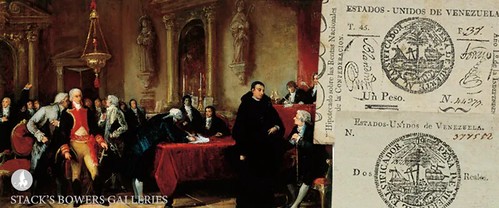
PREV ARTICLE
NEXT ARTICLE
FULL ISSUE
PREV FULL ISSUE
THE FIRST PAPER MONEY OF VENEZUELAStack's Bowers Director of Consignments & Senior Numismatist Dennis Hengeveld published an article on the earliest paper money of Venezuela. -Editor The notaphilic history of Venezuela starts in 1811, shortly after seven (out of ten) provinces of the Spanish colonial Captaincy General of Venezuela declared their independence in July of that year. Despite being very short-lived (the First Republic of Venezuela ceased to exist in late July of 1812, just over a year after it was declared), the first independent government still managed to issue its own banknotes. These banknotes were the first printed paper money in South America and are historically extremely significant. When it comes to the paper money issued by the First Republic of Venezuela the Pick catalog is incomplete. There were three separate emissions of paper money in 1811 and 1812. These different emissions (as listed in the Marcano catalog), can be identified by their signatures. The first was issued pursuant to the law of 27 August 1811, and consisted of 1 Peso, 2 Pesos, 4 Pesos, 8 Pesos and 16 Pesos notes (these are Pick-4 to Pick-8). Just a few months later, there was a shortage of small change, and a 2 Reales or 1/4 Peso note was introduced, which is Pick-2, issued pursuant to the law of 29 November 1811. Then, another series of 1 Peso to 16 Pesos notes were issued according to the decree of February 7, 1812. These are not separated in Pick except for the 1 Peso, which had a minor design change, and is listed as Pick-4A.
The notes were printed in Caracas using engraved wood plates on thick, handmade paper. There is typically a watermark visible, ranging from simple lines to various words, although on most surviving notes only part of a watermark is visible. During later printings the paper quality deteriorated as quantity became more important than quality. The design of the notes was simplistic, and except for signatures on the back on some denominations they were uniface. The main design element is a seal which included the text The Banknote Book states that the earliest notes were hand-signed, but most seen today have a stamped signature. As an anti-counterfeit measure a complicated numbering system was used on all notes but the 2 Reales. The numbering was not fully deciphered until the 1990s (by Andrés Núñez and later revised by Tomás Stohr). While the notes lacked financial backing and were easily counterfeited (and not popular with the general public as a result) they still represent the earliest paper money for Venezuela and South-America as a whole. After the First Republic of Venezuela fell in 1812, they were quickly withdrawn and all denominations are rare today. Several examples of this rare first issue are part of the Rio Arauca Collection of Venezuelan Paper Money, offered in our August 2024 Global Showcase Auction. The deadline is rapidly approaching but we are still taking consignments of notes from the Americas to be offered in this sale. To start the consignment process, please contact Stack's Bowers Galleries at 800-458-4646 or email Dennis Hengeveld at Dennis@stacksbowers.com.
To read the complete article, see:
Wayne Homren, Editor The Numismatic Bibliomania Society is a non-profit organization promoting numismatic literature. See our web site at coinbooks.org. To submit items for publication in The E-Sylum, write to the Editor at this address: whomren@gmail.com To subscribe go to: https://my.binhost.com/lists/listinfo/esylum All Rights Reserved. NBS Home Page Contact the NBS webmaster 
|

